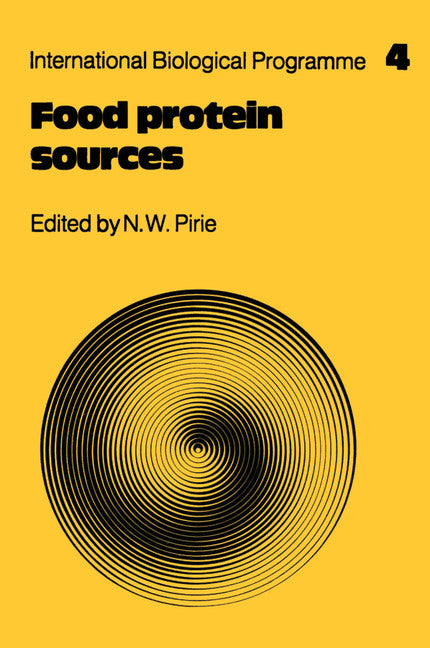Freshly Printed - allow 8 days lead
Couldn't load pickup availability
Food Protein Sources
First published in 1975, this book looks at the different ways in which food protein can be produced.
N. W. Pirie (Author)
9781107403826, Cambridge University Press
Paperback / softback, published 12 January 2012
284 pages
22.9 x 15.2 x 1.5 cm, 0.38 kg
This book was first published in 1975. Food protein can be produced in many different ways. Some sources, e.g. products from domestic animals, are so well known that they need only brief mention in a book such as this. Others necessitate the use of sophisticated technology; their merits and potentialities are discussed at sufficient length to allow their world role to be assessed and to illustrate the directions in which research is needed. Special attention is given to sources from which food protein could be made by simple techniques in regions where protein deficiency is acute. The methods discussed include mechanical extraction, biological modification, and biological conversion. The final section discusses quality control and the acceptability of novel foods.
List of contributors
Preface
Part I. Sources Edible after Minimal Processing: 1. Protein-rich cereal seeds A. K. Kaul
2. Varietal improvement of seed legumes in India L. M. Jeswani
3. Minor food seeds D. A. V. Dendy, Bernice Emmett and O. L. Oke
4. Vegetables F. W. Shepherd
5. The Spirulina algae N. W. Pirie
6. Green micro-algae H. Tamiya
Part II. Concentrates Made by Mechanical Extraction: 7. Protein products from coconuts D. A. Dendy
8. Soybeans: processing and products S. J. Circle and A. K. Smith
9. Rapeseed and other crucifers R. Ohlson and R. Sepp
10. Sunflower, safflower, sesame and castor protein Antoinette A. Betschart, C. K. Lyon and G. O. Kohler
11. Groundnut O. L. Oke, R. H. Smith and A. A. Woodham
12. Broad bean A. Hagberg and J. Sjödin
13. Concentrates by wet and dry processing of cereals R. M. Saunders and G. O. Kohler
14. Leaf protein N. W. Pirie
15. Industrial production of leaf protein in the USA G. O. Kohler and E. M. Bickoff
Part III. Concentrates Made by Biological Conversion: 16. Protein from non-domesticated herbivores K. L. Blaxter
17. The use of non-protein nitrogen by ruminants T. R. Preston
18. Non-protein nitrogen in pig nutrition R. Braude
19. The domestic non-ruminant animal as consumer and provider of protein A. A. Woodham
20. The conversion of animal products such as wool and feathers into food F. B. Shorland
21. Increasing the direct consumption of fish G. H. O. Burgess
22. Funghi W. E. Trevelyan
23. Yeasts grown on hydrocarbons C. A. Shacklady
24. Variation in the composition of bacteria and yeast and its significance to single-cell protein production C. L. Clooney and S. R. Tannenbaum
Part IV. The Use of Novel Foods: 25. Quality standards, safety and legislation F. Aylward
26. Acceptance of novel foods by the consumer R. P. Devadas
Index.
Subject Areas: Agriculture & farming [TV]


